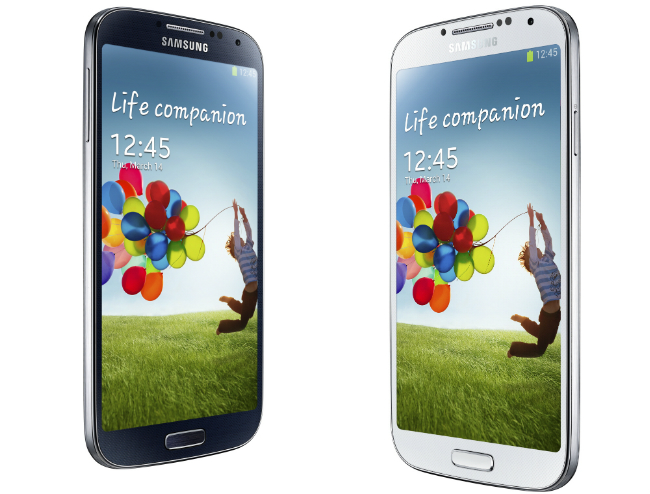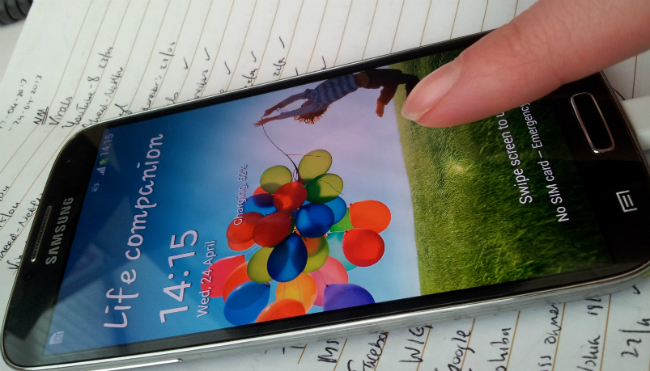Samsung Galaxy S4
Samsung’s Galaxy S4 has arrived and will probably be the biggest Android smartphone release of the year, what with Samsung’s previous dominance in this market with the S-series and the excitement and anticipation surrounding the launch. But can the S4 live up to the hype?
Look and feel
What first struck me about the Galaxy S4 is how light and compact it feels for a phone with a massive 5-inch display. When I first heard this specification I worried that Samsung was overshooting with display size and that the device would be unwieldy, but through some clever engineering the South Korean manufacturer has managed to create a handset that is lighter than and thinner than its predecessor, the Galaxy S III, at 130g and just 7.9mm thick.
Samsung has also improved on the design of the S III, which had too much of a plasticky feel for some, cheapening the look and feel of such a high-spec device. This has been addressed in the S4, however, which has been fitted with a less flimsy polycarbonate rear casing with a speckled design that gives the impression of a textured finish, but with a far more effective and elegant effect than the S III’s faux-brushed aluminium look. The chrome frame also looks and feels better than before, perfectly setting off the slim bezel at the front and complementing the raised lettering of the Samsung logo on the rear.

The S4 is available in black and white and, while it seemed to me more users opted for the white S III, I think consumers will be better off going back to black on this edition. This version completely disguises the numerous sensors and LED notification light embedded at the top of the device, giving it a cleaner appearance.
Finally, drawing the eye above all else, is the bright and clear Super AMOLED display. The S4 display offers full-HD resolution at 1,080 x 1,920, packing 441 pixels per inch. It’s nothing short of impressive in ideal conditions, however, in strong sunlight you won’t get the same consistency offered by the likes of the HTC One X+ or Nokia’s Lumia 920.
Smart user interface
With the S4 you’re getting the very latest from Android in the flavour Jelly Bean 4.2.2. This means you get to play around with the best of Google Play’s latest apps, such as Chrome’s mobile browser, the intuitive search of Google Now and the recently released note-taking app, Google Keep.
The Google-made operating system is overlaid with Samsung’s TouchWiz UI, which has its fans and critics but for my own personal use has always been easy to use and to find my way around. For users new to the smartphone experience, or even those making the switch to Samsung or Android, a simplified home screen can be enabled to make navigation on the device easier to get to grips with.
Specifications
- 5-inch Super AMOLED capacitive touchscreen display1,080 x 1,920 (441ppi)
- Corning Gorilla Glass 3
- 136.6mm x 69.8mm x 7.9mm, 130g
- Android 4.2.2 Jelly Bean
- Eight-core Exynos chipset/quad-core Qualcomm Snapdragon 600
- 16GB/32GB/64GB internal storage (expandable up to 64GB via micro-SD card)
- 2GB RAM
- Wi-Fi, DLNA, Bluetooth 4.0, DLNA, NFC, Infrared
- Available in 3G or 4G models
- Micro-USB 2.0
- 13MP rear camera, video recording at 1080p at 30fps
- 2MP front-facing camera, video recording at 1080p at 30fps
- 2,600mAh battery
The drop-down notifications menu gives users easy on/off controls for a vast number of settings, minimising the number of steps needed to make regular adjustments and ensuring users can stay in control of their device. The full settings menu has also been split into category tabs, which is much appreciated as these devices become more advanced and this menu grows ever longer.
Among these settings, you have the option to enable Samsung’s latest technologies. The Smart Stay innovation introduced with the S III – which observes users as they look at the phone’s display and ensures it stays active as long as they are looking at it – has been expanded to include Smart Pause, Smart Scroll and Smart Rotation.
Smart Pause will stop video playback if a user looks away from the screen, whether watching on the native video player or through the pre-loaded YouTube app. This is an addition that may be welcome to some but on the other hand can be seen as the phone becoming more demanding of users’ attention in a content-rich age where this has been noted as difficult to maintain.
Smart Scroll tracks users’ eye movements and scrolls up or down accordingly, without any need to touch the screen. This was a bit of a trip at first and highlighted how unfocused my own eyes are as the screen shifted up and down with every flicker. However, users are open to adjust the speed of scrolling and can switch from eye control to tilt responsiveness, which worked far better in my case.
Smart Rotation, however, was less useful. This setting is supposed to recognise the orientation of a user’s face and rotate the screen accordingly. Anyone who has ever tried to read an article lying down only for the screen to switch from portrait to landscape orientation in the process will understand the need for this setting but, unfortunately, results were inconsistent at best and simply turning off auto-rotation remains more effective.

As well as tracking your eye movement, the S4 can also recognise gestures without touch. Users can wave their hand across the screen to browse photos, switch between web pages, and skip tracks in the music player. Air gestures also come in handy when moving around apps and widgets on your home screen, and – my favourite feature of this innovation – waving your hand over the phone when in standby gives you a brief, at-a-glance view of your clock, battery status and notifications.
There’s also Air View, which allows users to preview albums, images, emails or progress bar status by hovering their pointing finger over the screen. This can also be used in the dialler app to preview the speed dial contacts assigned to each digit and to magnify content on web pages, scoring the S4 points for accessibility.

Highlight on the lock screen shows where the Galaxy S4 detects the position of the hovering finger
Extra screen real estate means you have small touches like a number keypad included across the top of the QWERTY input, as well as bigger improvements, like room for multi-tasking with a split screen. There’s also a pop-out video player, which means, like the larger Galaxy Note II, you can do three things on this screen at once.
App-wise, you have some new pre-loaded apps from Samsung, which I suppose attempt to fulfil the S4’s claim of being a ‘life companion’. Marketing taglines aside, S Translate and S Health will certainly come in handy for some users. The former recognises speech input and translates this into a number of languages, while the latter falls into the popular category of personal trainer apps and also comes equipped with a nutrition tracker.
Creative camera
The S4’s camera and the features that come with it are a real selling point for this smartphone. Finding and switching between scene modes is easy and it’s clearly explained what each one does and how it works.

Drama shot on the Galaxy S4 records an action sequence and merges movement into a single photograph
The HDR mode is underwhelming, but just about every other mode performs beautifully. There are also plenty of creative gimmicks to keep users entertained. Sound & Shot captures an image along with nine seconds of sound, Animated Image creates a GIF in which users can select what areas to animate, and Drama merges a number of action shots into a single image.
Perhaps most impressive is Best Face, which takes five shots in quick succession and allows users to select their subjects’ best expressions for the perfect group shot. The editing in these shots is seamless, with no one any wiser to the face transplants that have occurred.

Image on the left was shot using best face with both faces changed; image on right magnifies faces to show how seamless the process is
The S4 makes the most of both cameras’ ability to shoot 1080p video with dual-shot. This lets users shoot photos or video using both cameras at once, and can even be enabled when making video calls.
The camera can also be controlled by voice, responding to the words ‘smile’, ‘cheese’ and ‘capture’ and removing the possibility of camera shake when pressing the on-screen shutter button.
Performance
Samsung has continued to make its smartphone batteries removable, going against the trend of wrapping everything up in a tightly sealed package and giving users the option of carrying a spare battery. While the S4 packs a boosted 2,600mAh battery over the S III’s 2,100mAh, there’s still a lot for it to keep up with. If you opt to enable all of the smart and air gesture options available to you, you will notice faster drain. But, in general, you should get a full day’s power with average usage.
There are two versions of the S4 hitting markets worldwide: one with an eight-core Exynos chipset and another featuring Qualcomm’s quad-core Snapdragon 600 processor. The former clearly offers better performance but, unfortunately, European consumers are more likely to see the latter version.
This means attempting to do all of the things the S4 offers – which, remember, includes split-screen multi-tasking – with less-than-optimum processing power. That said, when the device does lag, it is brief and recovery is quick.
The S4 also has just about every connectivity option covered with Wi-Fi, 3G or 4G, Bluetooth, NFC, DLNA and infrared. The NFC chip can be used to wirelessly amplify music playback through pairing with other S4 handsets, while infrared can be enabled to turn the device into a remote control for various household electronics, such as a Samsung smart TV.
Siliconrepublic reviews the new Samsung Galaxy S 4
Verdict
I had plenty of fun using the Galaxy S4 and, as a Samsung owner myself, I very quickly became accustomed to its UI and new features were easy to master. While I can clearly see the practical uses of new apps like S Translate and S Health, as well as some of the innovations introduced with this device, the advances of the S4 are somewhat gimmicky and may be more likely to impress friends down at the pub than see everyday use. That said, the opportunities for photo creativity and multi-tasking sit well with me and I’m sure will be a huge draw for others.
For S III users, the step up to the S4 might not be enough of an advancement to satisfy them, but anyone with and S II or similar mid-range device that’s due an upgrade would do well to consider the S4.
Also, it’s worth noting that there are both 3G and 4G versions of the S4 available, so consumers hoping to make the most of Ireland’s eventual LTE rollout will want to make sure they pick up the right one.
The Samsung Galaxy S4 is available now from Carphone Warehouse at various price points on different networks.